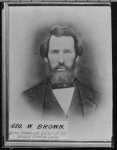
George W. Brown
The Peace Conference, Parts 1, 2, 3, 4
Wilson Shannon came into Lawrence and found a document waiting for him. Though antislavery writers habitually describe Shannon as weak, easily led, none too bright, and an explosion hazard in the presence of an open flame, they didn’t have quite the sucker they thought if they hoped that he would sign anything at all. He dug his feet in and Shannon, James Lane, and Charles Robinson spent a fair portion of December 8, 1856, in further negotiations. In they end they did reach an agreement, which the Herald of Freedom would print on January 12, 1856. Therein, George Washington Brown reports a rumor current as of the negotiations:
Judge Wm. A. Story, who visited the camp of the Missourians, […] tells me that up to eight o’clock Saturday morning peace negotiations had not been ratified; but not to be alarmed, that blood would not be shed. He says the Yankees offered to give up their arms, deliver the men who resisted the laws, and acknowledge the supremacy of the laws of Kansas Territory. Gen. Atchison made this statement to him.
This sounds plausible enough on the surface. At eight in the morning on Saturday, December 8, the proslavery besiegers and antislavery besieged had no agreement signed. The pledge to surrender arms doesn’t sound remotely plausible, even in light of Shannon’s version of events, but Atchison might have made the claim as part of the effort to prevent a wildcat attack on Lawrence.
Brown, who had the pleasure of experiencing Lawrence’s siege from the inside, did not feel judiciously inclined toward the Senator from Missouri:
If General Atchison made these statements, the arc-ruffian is a liar as well as a demagogue and traitor. Neither the Yankees in Kansas, nor the Free State soldiers who assembled at Lawrence, ever offered to deliver up their arms, nor promised obedience to the infamous enactments of the Ruffian Barons.

David Rice Atchison (D-MO)
To prove the point, Brown printed a copy of the settlement. He noted, with relish, that he had it in Shannon’s own hand and published it in defiance of the Governor’s wish to keep the details secret. By that point, of course, the document had long since leaked. Sure enough, it holds no mention of surrendering arms. Brown may have impugned Atchison’s character anyway; and few could blame him for it. But he had the facts on his side.
The treaty commences with reference to the “misunderstanding” over Jacob Branson’s rescue from Samuel Jones
and some other matters; and whereas a strong apprehension exists that said misunderstanding may lead to civil strife and bloodshed
Shannon and the people of Lawrence jointly committed themselves to
avert a calamity so disastrous to the interests of the Territory and the Union
As preambles go, this reads as remarkably even-handed. Shannon, Lane, and Robinson really did agree in wanting to avoid bloodshed and on the momentous risk that open battle might pose to the nation. Calling the affair fruit of a misunderstanding allowed everyone to save some face. But to this point, the treaty speaks only of how the dispute arose. The meat of the document follows in a remarkable run-on sentence that only the nineteenth century could love, which I shall break down issue-by-issue:
We, the said citizens of said Territory, protest that the said rescue was made without our knowledge and consent, but, if any of our citizens were engaged, we pledge ourselves to aid in the execution of any legal process against them

Wilson Shannon
Brown’s emphasis does not appear in other copies (Please see the correction below.) and likely did not appear in the original, but the emphasis preserves the free state position that Jones held no rightful office as sheriff and could serve no lawful warrants as he owed his position and power to the bogus legislature. At the same time, Shannon and others could read this as an affirmation of just the opposite. As a lawful sheriff, Jones could serve lawful warrants. Lawrence just agreed to that in black and white. The ambiguity served both parties, though in accepting Shannon as Kansas’ legal governor it leaned somewhat more in a proslavery direction.
The people of Lawrence further declared they had
no knowledge of the previous, present, or prospective existence of any organization in the said Territory for resistance against the laws, and that we have not designed, and do not design, to resist the legal service of any criminal process therein
The emphasis again. With one hand, the antislavery party concedes everything and with the other takes it back on the heels of a lie that everyone had to know. Of course they had an organization for resisting the laws, which they had designed and had in fact used to resist process. But they could parse the distinctions carefully enough to make the statement technically true. If it fooled no one, then it at least included a weak promise of future good conduct. The Missourians might take that as a sign that they had frightened Lawrence into submission.
Update: Since writing this post, I’ve gone over my copies of the treaty again and found that the one in Wilson Shannon’s version of events, available in Brewerton, does have italics where Brown does to emphasize the word legal. However, Brewerton’s copy also uses italics to emphasize other passages, both consistent with published versions of other period documents (whereas, provided further, etc) and selections particularly relevant to Shannon’s position and/or Brewerton’s own proslavery interests. As such, I still consider Brown’s choice of italics an editorial decision on his part, but I did error in saying that the other copies of the treaty at my disposal all lacked italics.
You must be logged in to post a comment.